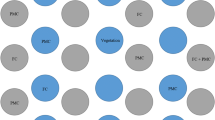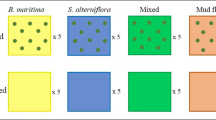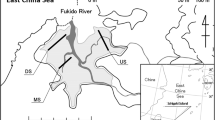Abstract
Many ecological processes are influenced by salinity. Burrowing crabs, abundant fauna of mangrove forests around the world, can facilitate sediment water fluxes, which may decrease the salinity in mangrove sediments. We investigated whether and how crab burrow density and secondary fine root biomass interact to drive sediment salinity during the dry season in a northern Brazilian mangrove forest. Areas with high density of Rhizophora mangle prop roots and areas free of such roots were compared. We found no correlation between burrow density and sediment salinity in areas with dense prop and fine roots, while crab density correlated negatively with sediment salinity in areas without prop roots, where fine root density was low. Hence, the strength of sediment desalination effects of crabs seems to be context dependent, and high root density of a salt-excluding mangrove species (R. mangle) seems to counteract the crabs’ effect. Our results complement those of a former study conducted in the same area during the rainy season, highlighting that the findings are independent from seasonality and should be considered when evaluating the overall ecological effects of crabs in mangrove ecosystems.
Similar content being viewed by others
References
Acheampong, E., 2001. Distribution of macrozoobenthos abundance and biomass in intertidal soft sediments of North-East Brazil. Master Thesis of the University of Bremen, Germany: 69.
Alongi, D. M., 2008. Mangrove forest: resilience, protection from tsunamis, and responses to global climate change. Estuarine, Coast and Shelf Science 76: 1–13.
Alongi, D. M., 2014. Carbon cycling and storage in mangrove forests. Annual Review of Marine Science 6: 195–219.
Alongi, D. M., K. G. Boto & F. Tirendi, 1989. Effect of exported mangrove litter on bacterial productivity and dissolved organic carbon fluxes in adjacent tropical nearshore sediments. Marine Ecology Progress Series 56: 133–144.
Boerger, W. A., M. R. Pie, A. Ostresky & L. Patella, 2005. Lethargic crab disease: multidisciplinary evidence supports a mycotic etiology. Memórias do Instituto Oswaldo Cruz 100(2): 161–167.
Boerger, W. A., M. R. Pie, V. Vicente, A. Ostresky, D. Hungria & G. G. Castilho, 2007. Histopathology of the mangrove land crab Ucides cordatus (Ocypodidae) affected by lethargic crab disease. INER-Research, Diseases of Aquatic Organisms 78: 73–81.
Bouillon, S., N. Koedam, A. V. Raman & F. Dehairs, 2002. Primary producers sustaining macro-invertebrate communities in intertidal mangrove forests. Oecologia 130: 441–448.
Castiglioni, D. S. & M. L. Negreiros-Fransozo, 2006. Ciclo reprodutivo do caranguejos violinista Uca rapax (Smith) (Crustacea, Brachyura, Ocypodidae) habitante de um estuário degradado em Paraty, Rio de Janeiro, Brasil. Revitsa Bresileira de Zoologia 23(2): 331–339.
Crane, J., 1975. Fiddler Crabs of the World: Genus Uca. Princeton University Press, Ocypididae. ISBN 0-691-08102-6.
Diele, K. 2000. Life history and population structure of the exploited mangrove crab Ucides cordatus cordatus (L.) (Decapoda: Brachyura) in the Caeté Estuary, North Brazil. Bremen, ZMT (Center For Marine Tropical Ecology), Contribution 9: 103.
Diele, K. & V. Koch, 2010. Growth and mortality of the exploited mangrove crab Ucides cordatus (Ucididae) in N-Brazil. Journal of Experimental Biology and Ecology 395: 171–180.
Diele, K., V. Koch & U. Saint-Paul, 2005. Population structure, catch composition and CPUE of the artisanally harvested mangrove crab Ucides cordatus (Ocypodidae) in the Caeté Estuary, North Brazil: Indications for overfishing? Aquatic Living Resources 18: 169–178.
Diele, K., V. Koch, F. A. Abrunhosa, J. de Farias Lima & D. de Jesus de Brito Simith, 2010. The Brachyuran Crab Community of the Caeté Estuary, North Brazil: species richness, zonation and abundance. In Mangrove Dynamics and Management in North Brazil, Ecological Studies 211, chapter 16: 251–263. DOI 10.1007/978-3-642-13457-9_16.
Ellison, A. M., 2008. Managing mangroves with benthic biodiversity in mind: moving beyond roving banditry. Journal of Sea Research 59: 2–15.
Faunce, C. H. & J. E. Serafy, 2006. Mangroves as fish habitat: 50 years of field studies. Marine Ecology Progress Series 318: 1–18.
Goes, P., J. O. Branco, M. A. A. Pinheiro, E. Barberi, D. Costa & L. L. Fernandes, 2010. Bioecology of the uçá-crab, Ucides cordatus (Linnaeus, 1763), in Vitória Bay, Espírito Santo State, Brazil. Brazilian Journal of Oceanography 58: 153–163. ISSN 1982-436X.
Gomes, V. J. C., P. T. A. Feitas & N. E. Asp, 2013. Dynamics and seasonality of the middle sector of a microtidal estuary. In Conley D.C., G. Masselink, P. E. Russell & T. J. O’Hare (eds), Proceedings 12th International Coastal Symposium (Plymount, England), Journal of Costal Research, Special Issue No. 65: 1140–1145. ISSN 0749-0208.
Heron, S. F. & P. V. Ridd, 2003. The effect of water density variations on the tidal flushing of animal burrows. Estuarine, Costal and Shelf Science 58: 137–145.
Heron, S. F. & P. V. Ridd, 2008. The tidal flushing of multiple-loop animal burrows. Estuarine, Costal and Shelf Science 78: 135–144.
Hollins, S., S. F. Herron & P. V. Ridd, 2009. Methods for monitoring tidal flushing in large animal burrows in tropical mangrove swamps. Estuarine, Costal and Shelf Science 82: 615–620.
INMET, 2015. Instituto Nacional de Meteorologia [available on internet at www.inmet.org.br]. Access on 10th of June, 2015.
Iribarne, O., A. Bortolus & F. Botto, 1997. Between-habitat differences in burrow characteristics and trophic modes in the southwestern Atlantic burrowing crab Chasmagnathus granulata. Marine Ecology Progress Series 155: 137–145.
Katz, L. C., 1980. Effects of burrowing by the fiddler crab, Uca pugnax (Smith). Estuarine and Coastal Marine Science 11: 233–237.
Kida, M., M. Tomotsune, Y. Iimura, K. Kinjo, T. Ohtsuka & N. Fujitake, 2017. High salinity leads to accumulation of soil organic carbon in mangrove soil. Chemosphere 177: 51–55.
Koch, V., M. Wolff & K. Diele, 2005. Comparative population dynamics of four sympatric fiddler crab species (Ocypodidae, Genus Uca) for a North Brazilian mangrove ecosystem. Marine Ecology Progress Series 291: 177–188.
Korting, J., 2012. Bioturbation activities of the mangrove crab Ucides cordatus – Method development and first quantification in the Caeté estuary, Pará, Brazil. Master Thesis presented to the University of Bremen, Faculty for Biology & Chemistry.
Kristensen, E., 2008. Mangrove crabs as ecosystem engineers; with emphasis on sediment processes. Journal of Sea Research 59: 30–43.
Lee, S. Y., 2008. Mangrove macrobenthos: assemblages, services, and linkages. Journal of Sea Research 59: 16–29.
Legat, J. F. A., R. L. Mota, A. Puchnick, C. Bittencourt & W. S. Santana, 2006. Considerations about Ucides cordatus cordatus fishing in the Parnaiba River Delta Region, Brazil. Journal of Coastal Research, SI 39 (Proceedings of the 8th International Coastal Symposium): 1281–1283. Itajai, SC, Brazil. ISSN 0749-0208.
Lim, S. S. L., 2006. Fiddler crab burrow morphology: How do burrow dimensions and bioturbative activities compare in sympatric populations of Uca vocans (Linnaeus, 1758) and U. annulipes (H. Milne Edwards, 1837)? Crustaceana 79: 525–540.
Mehlig, U., 2006. Phenology of the red mangrove, Rhizophora mangle L., in the Caeté Estuary, Pará, equatorial Brazil. Aquatic Botany 84: 158–164.
Menezes, M., U. Berger & M. Worbes, 2003. Annual growth rings and long-term growth patterns of mangroves trees from the Bragança Peninsula, North Brazil. Wetland Ecology and Management 11: 133–242.
Miller, D. C., 1961. The feeding mechanism of fiddler crabs, with ecological considerations of feeding adaptations. Zoologica 46: 89–101.
Moura, D. E., C. C. Lamparelli, F. O. Rodrigues & R. C. Vicent, 1998. Decomposição de folhas em manguezais na região de Bertioga, São Paulo, Brasil. Anais do IV Simpósio de Ecossistemas Brasileiros, Águas de Lindóia 1: 130–148.
Nascimento, D. M., R. R. N. Alves, R. R. D. Barboza, A. J. Schmidt, K. Diele & J. S. Mourão, 2017. Commercial relationships between intermediaries and harvesters of the mangrove crab Ucides cordatus (Linnaeus, 1763) in the Mamanguape River estuary, Brazil, and their socio-ecological implications. Ecological Economics 131: 44–51.
Nascimento Jr., W. R., P. W. M. Souza-Filho, C. Proisy, R. M. Lucas & A. Rosenqvist, 2013. Mapping changes in the largest continuous Amazonian mangrove belt using object-based classification of multisensor satellite imagery. Estuarine, Coastal and Shelf Science 117: 83–93.
Nordhaus, I., K. Diele & M. Wolff, 2009. Activity patterns, feeding and burrowing behaviour of the crab Ucides cordatus (Ucididae) in a high intertidal mangrove forest in North Brazil. Journal of Experimental Marine Biology and Ecology 374(2): 104–112.
Nordhaus, I., M. Wolff & K. Diele, 2006. Litter processing and population food intake of the mangrove crab Ucides cordatus in a high intertidal forest in northern Brazil. Estuarine, Coastal and Shelf Science 67: 239–250.
Ostrensky, A., U. S. Sternhain, E. Brun, F. X. Wegbecher & D. Pestana, 1995. Análise da viabilidade técnico-econômica dos cultivos do caranguejo-uçá Ucides cordatus (Linnaeus, 1763) no litoral paranaense. Arquivos de Biologia e Tecnologia 38(3): 939–947.
Parida, A. K. & B. Jha, 2010. Salt tolerance mechanisms in mangroves: a review. Trees 24: 199–217. doi:10.1007/s00468-010-0417-x.
Passioura, J. B., M. C. Ball & J. H. Knigth, 1992. Mangroves may salinize the soils and in so doing limit their transpiration rate. Functional Ecology 6: 476–481.
Pinheiro, J. C. & D. M. Bates, 2000. Mixed-Effects Models in S and S-PLUS. Springer, New York.
Pinheiro, J.C., D.M. Bates, S. DebRoy, D. Sarkar & R Core Team, 2012. nlme: linear and nonlinear mixed effects models.
Pinheiro, M. A. A. & G. Y. Hattori, 2006. Relative Growth of the Mangrove Crab Ucides cordatus (Linnaeus, 1763) (Crustacea, Brachyura, Ocypodidae) at Iguape, São Paulo, Brazil. Brazilian Archives of Biology and Technology 49: 813–823. ISSN 1516-8913.
Pinheiro, M. A. A., A. G. Fiscarelli & G. Y. Hattori, 2005. Growth of the mangrove crab Ucides cordatus (Brachyura, Ocypodidae). Journal of Crustacean Biology 25: 293–301.
Piou, C., U. Berger & I. F. Feller, 2009. Spatial structure of a leaf-removing crab population in a mangrove of North-Brazil. Wetlands Ecology and Management 17: 93–106.
Pülmanns, N., K. Diele, U. Mehlig & I. Nordhaus, 2014. Burrows of the semi-terrestrial crab Ucides cordatus enhance CO2 release in a North Brazilian mangrove forest. PLoS ONE 9(10): 1–13.
Pülmanns, N., I. Nordhaus, K. Diele & U. Mehlig, 2015. Artificial crab burrows facilitate desalting of rooted mangrove sediment in a microcosm study. Journal of Marine Science and Engineering 3: 539–559.
Pülmanns, N., U. Mehlig, I. Nordhaus, U. Saint-Paul & K. Diele, 2016. Mangrove crab Ucides cordatus removal does not affect sediment parameters and stipule production in a one year experiment in Northern Brazil. PLoS ONE 11(12): e0167375.
R Development Core Team, 2008. R: A language and environment for statistical computing. R Foundation for Statistical Computing, Vienna, Austria. ISBN 3-900051-07-0, URL http://www.R-project.org.
Reise, A. 2003. Estimates of biomass and productivity in fringe mangroves of North-Brazil. PhD Thesis of the Faculty of Biology and Chemistry of the University of Bremen, Germany. ZMT-Contribution 16. ISSN 0944-0143.
Rivera-Monroy, V. H., J. W. Day, R. R. Twilley, F. Vera-Herrera & C. Coronado-Molina, 1995. Flux of nitrogen and sediment in a fringe mangrove in Terminos Lagoon, Mexico. Estuarine, Coastal and Shelf Science 40: 139–160.
Sakho, I., V. Mesnage, Y. Copard, J. Deloffre, G. Faye, R. Lafite & I. Niang, 2015. A cross-section analysis of the sedimentary organic matter in a mangrove ecosystem under dry climate conditions: the Somone estuary, Senegal. Journal of African Earth Sciences 101: 220–231.
Schmidt, A. J., C. E. Bemvenuti & K. Diele, 2013. Sobre a definição da zona de Apicum e sua impotância ecológica para a população de Caranguejo-Uçá Ucides cordatus (Linnaeus, 1763). Boletim Técnico Científico. CEPENE, Tamandaré – PE – Vol. 19, No. 1: 9–25.
Schories, D., A. Barletta-Bergan, M. Barletta, U. Krumme, U. Mehlig & V. Rademaker, 2003. The keystone role of leaf-removing crabs in mangrove forests of North Brazil. Wetlands Ecology and Management 11: 243–255.
Schwendenmann, L., R. Riecke & R. J. Lara, 2006. Solute dynamics in a North Brazilian mangrove: the influence of sediment permeability and freshwater input. Wetlands Ecology and Management 14: 463–475. doi:10.1007/s11273-006-0008-1.
Smith III, T. J., 1987. Effects of seed predators and light level on the distribution of Avicennia marina (Forsk) Vierh in tropical, tidal forests. Estuarine, Coastal and Shelf Science 25: 43–51.
Smith III, T. J., K. G. Boto, S. D. Frusher & R. L. Giddins, 1991. Keystone species and mangrove forest dynamics: the influence of burrowing by crabs on soil nutrient status and forest productivity. Estuarine, Costal and Shelf Science 33: 419–432.
Stieglitz, T., J. F. Clark & G. J. Hancock, 2013. The mangrove pump: the tidal flushing of animal burrows in a tropical mangrove forest determined from radionuclide budgets. Geochimica et Cosmochimica Acta 102: 12–22.
Stieglitz, T., P. Ridd & P. Müller, 2000. Passive irrigation and functional morphology of crustacean burrows in a tropical mangrove swamp. Hydrobiology 421: 69–76.
Twilley, R. R., S. C. Snedaker, A. Yánez-Arancibia & E. Medina, 1995. Mangroves systems. In Global Biodiversity Assessment, Biodiversity and Ecosystem Function: Ecosystem Analysis. Cambridge University Press, Cambridge: 387–393.
Wang, J. Q., X. D. Zhang, L. F. Jiang, M. D. Bertness, C. M. Fang, J. K. Chen, T. Hara & B. Li, 2010. Bioturbation of burrowing crabs promotes sediment turnover and carbon and nitrogen movements in an estuarine salt marsh. Ecosystems 13: 586–599.
Wolanski, E. & R. Gardiner, 1981. Flushing of salt from mangrove swamps. Marine and Freshwater Research 32: 681–683.
Wunderlich, A. C., M. A. A. Pinheiro & A. M. T. Rodrigues, 2008. Biologia do caranguejo-uçá, Ucides cordatus (Crustacea: Decapoda: Brachyura), na Baía da Babitonga, Santa Catar Santa Catarina, Brasil. Revista Brasileira de Zoologia 25(2): 188–198.
Xin, P., G. Jin, L. Li & D. A. Barry, 2009. Effect of crab burrows on pore water flows in salt marshes. Advances in Water Resources 32: 439–449.
Zuur, A. F., E. N. Ieno, N. Walker, A. A. Saveliev & G. M. Smith, 2009. Mixed Effects Models and Extensions in Ecology with R. Springer, New York.
Zuur, A. F., E. N. Ieno & C. S. Elphick, 2010. A protocol for data exploration to avoid common statistical problems. Methods in Ecology and Evolution 1: 3–14.
Acknowledgements
The authors would like to thank the University of Pará (UFPA), and Dr. Moirah Menezes and Dr. Ulf Mehlig for the support during the field work. The authors would also like to thank Dr. Thiago Branquinho de Queiroz from the Universidade Federal do ABC (São Paulo) for all support provided. Karen Diele received funding from the MASTS pooling initiative (The Marine Alliance for Science and Technology for Scotland), and its support is gratefully acknowledged. MASTS is funded by the Scottish Funding Council (Grant Reference HR09011) and contributing institutions.
Author information
Authors and Affiliations
Corresponding author
Additional information
Guest editors: K. W. Krauss, I. C. Feller, D. A. Friess, R. R. Lewis III / Causes and Consequences of Mangrove Ecosystem Responses to an Ever-Changing Climate
Rights and permissions
About this article
Cite this article
Pestana, D.F., Pülmanns, N., Nordhaus, I. et al. The influence of crab burrows on sediment salinity in a Rhizophora-dominated mangrove forest in North Brazil during the dry season. Hydrobiologia 803, 295–305 (2017). https://doi.org/10.1007/s10750-017-3282-4
Received:
Revised:
Accepted:
Published:
Issue Date:
DOI: https://doi.org/10.1007/s10750-017-3282-4












